Equestrianism
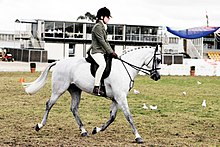
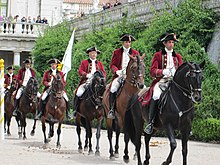

Equestrianism(fromLatinequester,equestr-,equus,'horseman', 'horse'),[2]commonly known ashorse riding(Commonwealth English) orhorseback riding(American English),[3]includes the disciplines of riding,driving,andvaulting.This broad description includes the use ofhorsesfor practicalworkingpurposes, transportation, recreational activities, artistic or cultural exercises, andcompetitive sport.
Overview of equestrian activities
[edit]
Horses aretrainedand ridden for practical working purposes, such as inpolice workor for controlling herd animals on aranch.They are also used incompetitive sportsincludingdressage,endurance riding,eventing,reining,show jumping,tent pegging,vaulting,polo,horse racing,driving,androdeo(see additional equestrian sports listed later in this article for more examples). Some popular forms of competition are grouped together athorse showswhere horses perform in a wide variety of disciplines. Horses (and otherequidssuch asmules) are used for non-competitive recreational riding, such asfox hunting,trail riding,orhacking.There is public access to horse trails in almost every part of the world; many parks,ranches,and publicstablesoffer both guided and independent riding. Horses are also used fortherapeuticpurposes both in specialized para-equestrian competition as well as non-competitive riding to improve human health and emotional development.
Horsesare alsodriveninharness racing,athorse shows,and in other types of exhibition such ashistorical reenactmentor ceremony, often pullingcarriages.In some parts of the world, they are still used for practical purposes such asfarming.[4]
Horses continue to be used in public service, in traditional ceremonies (parades, funerals),policeand volunteer mounted patrols and formounted search and rescue.[5]
Riding halls,also known as indoor arenas or schools, enable training of horse and rider in all weathers as well as indoor competition riding.[6]
History of horse use
[edit]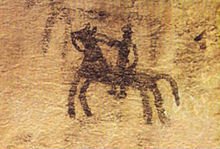
Though there is controversy over the exact date horses weredomesticatedand when they were first ridden, the best estimate is that horses first were ridden approximately 3500 BC. There is some evidence that about 3,000 BC, near theDnieper Riverand theDon River,people were usingbitson horses, as astallionthat was buried there shows teeth wear consistent with using a bit.[7]However, the most unequivocal earlyarchaeologicalevidence of equines put to working use was of horses being driven.Chariotburials about 2500 BC present the most direct hard evidence of horses used asworking animals.In ancient times chariot warfare was followed by the use ofwar horsesas light and heavycavalry.The horse played an important role throughout human history all over the world, both in warfare and in peaceful pursuits such astransportation,tradeandagriculture.Horses lived in North America, but died out at the end of theIce Age.Horses were brought back to North America by European explorers, beginning with the second voyage ofColumbusin 1493.[8]Equestrianism was introduced in the1900 Summer Olympicsas an Olympic sport with jumping events.[9]
Horse racing
[edit]Humans appear to have long expressed a desire to know which horse or horses were the fastest, andhorse racinghas ancient roots.Gamblingon horse races appears to go hand-in hand with racing and has a long history as well.Thoroughbredshave the pre-eminent reputation as a racing breed, but other breeds also race.
Types of horse racing
[edit]Under saddle:
- Thoroughbred horse racingis the most popular form worldwide. In the UK, it is known asflat racingand is governed by theJockey Clubin the United Kingdom. In the US, horse racing is governed by theJockey Club.other light breeds are also raced worldwide.
- Steeplechasinginvolves racing on a track where the horses also jump over obstacles. It is most common in the UK, where it is also calledNational Huntracing.
In harness:
- Both light and heavy breeds as well as ponies are raced in harness with asulkyor racing bike. TheStandardbreddominates the sport in bothtrottingandpacingvarieties.
- The United States Trotting Association organizesharness racingin the United States.
- Harness racing is also found throughout Europe, New Zealand and Australia.
Distance racing:
- Endurance riding,takes place over a given, measured distance and the horses have an even start. Top level races are usually 50 to 100 miles (80 to 161 km), over mountainous or other natural terrain, with scheduled stops to take the horses' vital signs, check soundness and verify that the horse is fit to continue. The first horse to finish and be confirmed by the veterinarian as fit to continue is the winner. Limited distance rides of about 25–20 miles (40–32 km) are offered to newcomers. Variants includeRide and Tieand various forms oflong riding.[10]
International and Olympic disciplines
[edit]Equestrian events were first included in the modernOlympic Gamesin 1900. By 1912, all three Olympic disciplines still seen today were part of the games. The following forms of competition are recognized worldwide and are a part of theequestrian eventsat the Olympics. They are governed by the rules of theInternational Federation for Equestrian Sports(FEI).
- Dressage( "training" inFrench) involves the progressive training of the horse to a high level ofimpulsion,collectionand obedience.[11]Competitive dressage has the goal of showing the horse carrying out, on request, the natural movements that it performs without thinking while running loose.
- Show jumpingcomprises a timed event judged on the ability of the horse and rider to jump over a series of obstacles, in a given order and with the fewest refusals or knockdowns of portions of the obstacles. Show jumping is also one of the five events in themodern pentathlon.However, due to recent controversy surrounding the safety of the horse and rider, show jumping is set to be removed from the modern pentathlon starting the 2028 Olympics.[12]
- Eventing,also calledcombined training,horse trials,thethree-day event,the Militaryorthe complete test,puts together the obedience of dressage with the athletic ability of show jumping, the fitness demands thecross-country jumpingphase. In the last-named, the horses jump over fixed obstacles, such as logs, stone walls,banks,ditchesandwater,trying to finish the course under the "optimum time". There was also the 'Steeple Chase' Phase, which is now excluded from most major competitions to bring them in line with the Olympic standard.
The additional internationally sanctioned but non-Olympic disciplines governed by theFEIare:combined driving;endurance;reining;andvaulting.These disciplines are part of theFEI World Equestrian Gamesevery four years and may hold their own individual World Championships in other years. The FEI also recognizeshorseballandtent peggingas its two regional disciplines.
Para-equestrian disciplines
[edit]Para-equestriancompetition at the international level, including theParalympics,are also governed by the FEI and offer the following competition events:
- Para-Equestrian Dressage is conducted under the same rules as conventional Dressage, but with riders divided into different competition grades based on their functional abilities.[13]
- Para-Equestrian Driving places competitors in grades based on their skill.[14]
Haute École
[edit]Thehaute école(F."high school" ), an advanced component ofClassical dressage,is a highly refined set of skills seldom used in competition but often seen in demonstration performances.
The world's leading Classical dressage programs include:
- TheCadre NoirinSaumur,France.
- TheSpanish Riding SchoolinVienna,Austria.
- ThePortuguese School of Equestrian ArtatQueluz National Palace,Portugal.
- TheRoyal Andalusian School of Equestrian ArtinJerez de la Frontera,Spain.
Other major classical teams include theSouth African Lipizzanersand theHollandsche Manegeof theNetherlands.
Horse shows
[edit]Horse showsare held throughout the world with a tremendous variety of possible events, equipment, attire, and judging standards used. However, most forms of horse show competition can be broken into the following broad categories:
- Equitation,sometimes calledseat and handsorhorsemanship,refers to events where the rider is judged on form, style and ability.
- Pleasure, flatorunder saddleclasses feature horses who are ridden on the flat (not jumped) and judged on manners, performance, movement, style and quality.
- Halter, in-hand breedingorconformationclasses, where the horse is led by a handler on the ground and judged on conformation and suitability as a breeding animal.
- Harnessclasses, where the horse isdrivenrather than ridden, but still judged on manners, performance and quality.
- JumpingorOver Fencesrefers broadly to bothshow jumpingandshow hunter,where horses and riders must jump obstacles.
English riding
[edit]
In addition to the classical Olympic events, the following forms of competition are seen. In North America they are referred to as "English riding"in contrast with western riding; elsewhere in the world, if a distinction is necessary, they are usually described as" classic riding ": There is no horn.
- Hunt seatorHunterclasses judge the movement and the form of horses suitable for work over fences. A typicalshow hunterdivision would include classes over fences as well as "Hunter under Saddle" or "flat" classes (sometimes called "hack" classes), in which the horse is judged on its performance, manners and movement without having to jump. Hunters have a long, flat-kneed trot, sometimes called "daisy cutter" movement, a phrase suggesting a good hunter could slice daisies in a field when it reaches its stride out. The over fences classes inshow huntercompetition are judged on the form of the horse, its manners and the smoothness of the course. A horse with good jumping form snaps its knees up and jumps with a goodbascule.It should also be able to canter or gallop with control while having a stride long enough to make a proper number of strides over a given distance between fences. Hunter classes differ from jumper classes, in which they are not timed, and equitation classes, in which the rider's performance is the focus. Hunter style is based on fox hunting, so jumps in the hunter division are usually more natural colors than the jumps in a jumper division.
- Eventing,show jumpinganddressage,described under "Olympic disciplines", above are all "English" riding disciplines that in North America sometimes are loosely classified within the "hunt seat" category.
- Saddle seat,is a primarily American discipline, though has recently become somewhat popular inSouth Africa,was created to show to best advantage the animated movement of high-stepping and gaited breeds such as theAmerican Saddlebredand theTennessee Walker.ArabiansandMorgansmay also be shown saddle seat in the United States. There are usually three basic divisions.Parkdivisions are for the horses with the highest action.Pleasuredivisions still emphasis animated action, but to a lesser degree, with manners ranking over animation.PlantationorCountrydivisions have the least amount of animation (in some breeds, the horses are flat-shod) and the greatest emphasis on manners.
- Show hackis a competition seen primarily in the United Kingdom, Australia and other nations influenced by British traditions, featuring horses of elegant appearance, with excellent way of going and self-carriage. A related event isriding horse.
Western riding
[edit]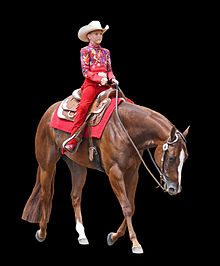
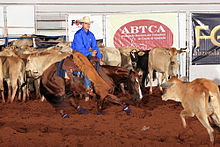
Western ridingevolved from the cattle-working and warfare traditions brought to the Americas by theSpanishsettlers,and both equipment and riding style evolved to meet the working needs of thecowboyonranchesin theAmerican West.
The most noticeable feature of western style riding is thewestern saddle,which has a substantialsaddle treethat provides support to horse and rider when working long hours in the saddle. The western saddle features a prominent pommel topped by a horn (a knob used for dallying alariatafter roping an animal), widestirrups,and in some cases, both front and back cinches. The depth of the seat may depend on the activity, a deeper seat used forbarrel racingorcutting cowsor a more shallow seat for general ranch riding orSteer wrestling.
Finished western horses are asked to perform with a loose rein controlled by one hand. The headstall of a western bridle may utilize either aSnaffle bitorcurb bit.Bitless headstalls are also seen, such as abosal-stylehackamoreon younger horses, or various styles ofmechanical hackamore.InVaquero style training,a combination of a bosal and bit, called a "two-rein", is used at some stages of training. The standard western bridle lacks anosebandand usually consists of a single set of reins attached to acurb bitthat has somewhat longershanksthan the curb of an EnglishWeymouthbridle or apelham bit.Western bridles have either abrowbandor else a "one ear" loop (sometimes two) that crosses in front of the horse's ear. Two styles of Westernreinsdeveloped: The long split reins of the Texas tradition, which are completely separated, or the "Romal"reins of the California tradition, which are closed reins with a long single attachment (the romal) that can be used as aquirt.Modernrodeocompetitors in timed events sometimes use a closed rein without aromal.
Western riders wear a long-sleeved shirt, long pants or jeans,cowboy boots,and a wide-brimmedcowboy hat.A rider may wear protective leather leggings calledchaps.Riders may wear brighter colors or finer fabrics in competition than for work. In particular, horse show events such asWestern pleasuremay much flashier equipment. Saddles, bits and bridles are ornamented with substantial amounts of silver, rider clothing may have vivid colors and even rhinestones or sequins.[15]
Harness
[edit]
Horses,ponies,mulesanddonkeysare driven inharnessin many different ways. For working purposes, they can pull aplowor otherfarmequipment designed to be pulled by animals. In many parts of the world they still pullwagonsfor basic hauling and transportation. They may drawcarriagesat ceremonies, in parades or for tourist rides.
As noted in "horse racing"above,horses can race in harness, pulling a very lightweight cart known as asulky.At the other end of the spectrum, somedraft horsescompete inhorse pullingcompetitions, where single or teams of horses and their drivers vie to determine who can pull the most weight for a short distance.
Inhorse showcompetition, the following general categories of competition are seen:
- Combined driving,an internationally recognized competition where horses perform an arena-based "dressage" class where precision and control are emphasized, a cross-country "marathon" section that emphasizes fitness and endurance, and a "stadium" or "cones" obstacle course.
- Draft horse showing:Mostdraft horseperformance competition is done in harness.
- Pleasure driving:Horses and ponies are usually hitched to a light cart shown at a walk and two speeds of trot, with an emphasis on manners.
- Fine harness:Also called "Formal driving", Horses are hitched to a light four-wheeled cart and shown in a manner that emphasizes flashy action and dramatic performance.
- Roadster:A horse show competition where exhibitors wearracing silksand ride in a sulky in a style akin toharness racing,only without actually racing, but rather focusing on manners and performance.
- Carriagedriving, using somewhat larger two or four wheeled carriages, often restoredantiques,judged on the turnout/neatness or suitability of horse and carriage.
Rodeo
[edit]Rodeo events include the following forms of competition:
Timed events
[edit]- Barrel racingandpole bending– the timed speed and agility events seen inrodeoas well asgymkhanaorO-Mok-Seecompetition. Both men and women compete in speed events at gymkhanas or O-Mok-Sees; however, at most professional, sanctioned rodeos, barrel racing is an exclusively women's sport. In a barrel race, horse and rider gallop around a cloverleaf pattern of barrels, making agile turns without knocking the barrels over. In pole bending, horse and rider run the length of a line of six upright poles, turn sharply and weave through the poles, turn again and weave back, then return to the start.
- Steer wrestling– Also known as "Bulldogging", this is a rodeo event where the rider jumps off his horse onto a steer and 'wrestles' it to the ground by grabbing it by the horns. This is probably the single most physically dangerous event in rodeo for the cowboy, who runs a high risk of jumping off a running horse head first and missing the steer or of having the thrown steer land on top of him, sometimes horns first.
- Goat tying– usually an event for women or pre-teen girls and boys, a goat is staked out while a mounted rider runs to the goat, dismounts, grabs the goat, throws it to the ground and ties it in the same manner as a calf. This event was designed to teach smaller or younger riders the basics of calf roping without the more complex need to also lasso the animal.
Roping
[edit]Roping includes a number of timed events that are based on the real-life tasks of a working cowboy, who often had to capture calves and adultcattleforbranding,medical treatment and other purposes. A lasso orlariatis thrown over the head of acalfor the horns of adult cattle, and the animal is secured in a fashion dictated by its size and age.
- Calf roping,also called "tie-down roping", is an event where a calf is roped around the neck by alariat,the horse stops and sets back on the rope while the cowboy dismounts, runs to the calf, throws it to the ground and ties three feet together. (If the horse throws the calf, the cowboy must lose time waiting for the calf to get back to its feet so that the cowboy can do the work. The job of the horse is to hold the calf steady on the rope) This activity is still practiced on modern working ranches forbranding,medical treatment, and so on.
- Team roping,also called "heading and heeling", is the only rodeo event where men and women riders may compete together. Two people capture and restrain a full-grown steer. One horse and rider, the "header", lassos a running steer's horns, while the other horse and rider, the "heeler", lassos the steer's two hind legs. Once the animal is captured, the riders face each other and lightly pull the steer between them, so that it loses its balance, thus in the real world allowing restraint for treatment.
- Breakaway roping– an easier form of calf roping where a very short lariat is used, tied lightly to the saddle horn with string and a flag. When the calf is roped, the horse stops, allowing the calf to run on, flagging the end of time when the string and flag breaks from the saddle. In the United States, this event is primarily for women of all ages and boys under 12, while in some nations where traditional calf roping is frowned upon, riders of both genders compete.
"Rough Stock" competition
[edit]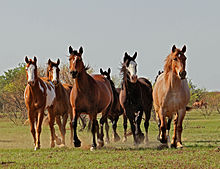
In spite of popular myth, most modern "broncs" are not in fact wild horses,[16]but are more commonly spoiled riding horses[citation needed]or horses bred specifically as bucking stock.
- Bronc riding – there are two divisions in rodeo,bareback broncriding, where the rider rides a bucking horse holding onto a leathersurcingleor rigging with only one hand, andsaddle broncriding, where the rider rides a modified western saddle without a horn (for safety) while holding onto a braided lead rope attached to the horse's halter.
- Bull Riding – though technically not an equestrian event, as the cowboys ride full-grown bulls instead of horses, skills similar to bareback bronc riding are required.
International rodeo
[edit]Other equestrian activities
[edit]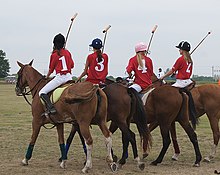
There are many other forms of equestrian activity and sports seen worldwide. There are both competitive events andpleasure ridingdisciplines available.
Arena sports
[edit]- ArenapoloandCowboy polo
- Pato(Argentina's national sport)
- Equestrian vaulting:In vaulting, asurcinglewith two hoops at the top is attached around a horse'sbarrel.The horse also wears abridlewithside reins.The vaulter islongedon the horse, and performsgymnasticmovements while the horse walks, trots, and canters.
- Gymkhana,competition of timed pattern games, also known asO-Mok-Seein the western United States.
Horse sports that use cattle
[edit]- Bullfighting(rejoneo)
- Campdrafting,a type of cattle-working competition popular inAustralia
- Cutting
- Team penning
- Working cow horse
Defined area sports
[edit]- Buzkashi,a sport originating on thesteppesof centralAsia,now the national sport ofAfghanistanandKyrgyzstan.
- Cowboy mounted shooting
- Horseball
- JoustingandSkill at Arms,events involving use of lances, swords and completion of obstacles. There are stand-alone competitions and also are often seen athistorical reenactments,Renaissance FairsandSociety for Creative Anachronismevents.
- Mounted archery
- Mounted Games,a sport where games are played in a relay-style with two to five members per team at very high speed
- Polo,a team game played on horses, involves riders using a long-handledmalletto drive a ball on the ground into the opposing team'sgoalwhile the opposing team defends their goal
- Polocrosse
- Tent pegging
Cross-country sports
[edit]- Competitive Mounted Orienteering,a form of orienteering on horses (but unrelated toorienteering) – consists of three stages: following a precise route marked on a map, negotiation of obstacles and control of paces.
- Le Trec,which comprises three phases – trail riding, with jumping and correct basic flatwork. Le Trec, which is very popular in Europe, tests the partnership's ability to cope with an all-day ride across varied terrain, route finding, negotiating natural obstacles and hazards, while considering the welfare of the horse, respecting the countryside and enjoying all it has to offer.
- Competitive trail riding,apace raceheld across terrain similar toendurance riding,but shorter in length (25 – 35 miles (56 km), depending on class). Being a form ofpace race,the objective is not to finish in the least time. Instead, as in other forms ofjudged trail riding,each competitor is graded on everything including physical condition, campsite and horse management. Horsemanship also is considered, including how the rider handles the trail and how horse is handled and presented to the judge and vet throughout the ride. The horse is graded on performance, manners, etc. "Pulse and respiration" stops check the horse's recovery ability. The judges also set up obstacles along the trail and the horse and rider are graded on how well they perform as a team. The whole point is the partnership between the horse and rider.
- Cross Country Jumping,a jumping course that contains logs and natural obstacles mostly. The common clothes worn are usually brighter colors and less conservative.
- Endurance riding,a competition usually of 50 to 100 miles (160 km) or more, over mountainous or other natural terrain, with scheduled stops to take the horses' vital signs, check soundness and verify that the horse is fit to continue. The first horse to finish and be confirmed by the veterinarian as fit to continue is the winner. Additional awards are usually given to the best-conditioned horses who finish in the top 10.
- Fox hunting
- Hacking, orpleasure riding.
- Hunter Pacingis a sport where a horse and rider team travel a trail at speeds based the ideal conditions for the horse, with competitors seeking to ride closest to that perfect time. Hunter paces are usually held in a series. Hunter paces are usually a few miles long and covered mostly at a canter or gallop. The horsemanship and management skills of the rider are also considered in the scoring, and periodic stops are required for veterinarians to check the vital signs and overall soundness of the horses.
- Ride and Tieis a form ofendurance ridingin which teams of 3 (two humans and one horse) alternate running and riding.
- Steeplechase,a distance horse race with diverse fence and ditch obstacles.
- Trail Riding,pleasure riding any breed horse, any style across the land.
Health issues
[edit]Handling, riding and driving horses have inherent risks. Horses are large prey animals with a well-developedflight or fight instinctable to move quickly and unexpectedly. When mounted, the rider's head may be up to 4 m (13 ft) from the ground, and the horse may travel at a speed of up to 65 km/h (40 mph).[17]The injuries observed range from very minor injuries to fatalities.
A study inGermanyreported that therelative riskof injury from riding a horse, compared to riding a bicycle, was 9 times higher foradolescentsand 5.6 times higher for youngerchildren,but that riding a horse was less risky than riding amoped.[18]InVictoria, Australia,a search of state records found that equestrian sports had the third highest incidence of serious injury, aftermotor sportsandpower boating.[19]InGreece,an analysis of a national registry estimated the incidence of equestrian injury to be 21 per 100,000 person-years for farming and equestrian sports combined, and 160 times higher forhorse racingpersonnel. Other findings noted that helmets likely prevent traumatic brain injuries.[20]
In theUnited Stateseach year an estimated 30 million people ride horses, resulting in 50,000emergency departmentvisits (1 visit per 600 riders per year).[21]A survey of 679 equestrians in Oregon, Washington and Idaho estimated that at some time in their equestrian career one in five will be seriously injured, resulting in hospitalization, surgery or long-term disability.[22]Among survey respondents, novice equestrians had an incidence of any injury that was threefold over intermediates, fivefold over advanced equestrians, and nearly eightfold over professionals. Approximately 100 hours of experience are required to achieve a substantial decline in the risk of injury. The survey authors conclude that efforts to prevent equestrian injury should focus on novice equestrians.
Mechanisms of injury
[edit]The most common injury is falling from the horse, followed by being kicked, trampled and bitten. About 3 out of 4 injuries are due to falling, broadly defined.[23][24]A broad definition of falling often includes being crushed and being thrown from the horse, but when reported separately each of these mechanisms may be more common than being kicked.[25][26]
Types and severity of injury
[edit]InCanada,a 10-year study of trauma center patients injured while riding reported that although 48% had suffered head injuries, only 9% of these riders had been wearing helmets at the time of their accident. Other injuries involved the chest (54%), abdomen (22%) and extremities (17%).[27]A German study reported that injuries in horse riding are rare compared to other sports, but when they occur they are severe. Specifically, they found that 40% of horse riding injuries were fractures, and only 15% were sprains. Furthermore, the study noted that in Germany, one quarter of all sport related fatalities are caused by horse riding.[28] Most horse related injuries are a result of falling from a horse, which is the cause of 60–80% of all such reported injuries.[23][29]Another common cause of injury is being kicked by a horse, which may cause skull fractures or severe trauma to theinternal organs.Some possible injuries resulting from horse riding, with the percent indicating the amounts in relation to all injuries as reported by aNew Zealandstudy,[30]include:
- Arm fracture or dislocation (31%)
- Head injury (21%)
- Leg fracture or dislocation (15%)
- Chest injury (33%)
Among 36 members and employees of theHong Kong Jockey Clubwho were seen in a trauma center during a period of 5 years, 24 fell from horses and 11 were kicked by the horse. Injuries comprised: 18 torso; 11 head, face or neck; and 11 limb.[31]The authors of this study recommend that helmets, face shields and body protectors be worn when riding or handling horses.
InNew South Wales,Australia,a study of equestrians seen at one hospital over a 6-year period found that 81% were wearing a helmet at the time of injury, and that helmet use both increased over time and was correlated with a lower rate of admission.[32]In the second half of the study period, of the equestrians seen at a hospital, only 14% were admitted. In contrast, a study of child equestrians seen at a hospital emergency department inAdelaidereported that 60% were admitted.[33]
In the United States, an analysis ofNational Electronic Injury Surveillance System(NEISS) data performed by the Equestrian Medical Safety Association studied 78,279 horse-related injuries in 2007: "The most common injuries included fractures (28.5%); contusions/abrasions (28.3%); strain/sprain (14.5%); internal injury (8.1%); lacerations (5.7%); concussions (4.6%); dislocations (1.9%); and hematomas (1.2%). Most frequent injury sites are the lower trunk (19.6%); head (15.0%); upper trunk (13.4%); shoulder (8.2%); and wrist (6.8%). Within this study patients were treated and released (86.2%), were hospitalized (8.7%), were transferred (3.6%), left without being treated (0.8%), remained for observation (0.6%) and arrived at the hospital deceased (0.1%)."[34]
Head injuries
[edit]Horseback riding is one of the most dangerous sports, especially in relation to head injury. Statistics from the United States, for example, indicate that about 30 million people ride horses annually.[35]On average, about 67,000 people are admitted to the hospital each year from injuries sustained while working with horses.[36]15,000 of those admittances are from traumatic brain injuries. Of those, about 60 die each year from their brain injuries.[37]Studies have found horseback riding to be more dangerous than several sports, including skiing, auto racing and football.[27]Horseback riding has a higher hospital admittance rate per hours of riding than motorcycle racing, at 0.49 per thousand hours of riding and 0.14 accidents per thousand hours, respectively.[27]
Head injuries are especially traumatic in horseback riding. About two-thirds of all riders requiring hospitalization after a fall have sustained a traumatic brain injury.[38]Falling from a horse without wearing a helmet is comparable to being struck by a car.[39]Most falling deaths are caused by head injury.[39]
The use of riding helmets substantially decreases the likelihood and severity of head injuries. When a rider falls with a helmet, he or she is five times less likely to experience a traumatic brain injury than a rider who falls without a helmet.[38]Helmets work by crushing on impact and extending the length of time it takes the head to stop moving.[40]Despite this, helmet usage rates in North America are estimated to be between eight and twenty percent.[41]
Once a helmet has sustained an impact from falling, that part of the helmet is structurally weakened, even if no visible damage is present.[42]Helmet manufacturers recommend that a helmet that has undergone impact from a fall be replaced immediately. In addition, helmets should be replaced every three to five years; specific recommendations vary by manufacturer.[43]
Rules on helmet use in competition
[edit]Many organizations mandate helmet use in competition or on show grounds, and rules have continually moved in the direction of requiring helmet use. In 2011, the United States Equestrian Federation passed a rule making helmet use mandatory while mounted on competition grounds at U.S. nationally rated eventing competitions.[44]Also in 2011, the United States Dressage Federation made helmet use in competition mandatory for all riders under 18 and all riders who are riding any test at Fourth Level and below.[45]If a rider competing at Prix St. Georges and above is also riding a test at Fourth Level or below, he or she must also wear a helmet at all times while mounted.
Riding astride
[edit]
The idea that riding a horse astride could injure a woman's sex organs is a historic, but sometimes popular even today, misunderstanding or misconception, particularly that riding astride can damage thehymen.[46]Evidence of injury to any female sex organs is scant. In female high-level athletes, trauma to theperineumis rare and is associated with certain sports (seePelvic floor#Clinical significance). The type of trauma associated withequestrian sportshas been termed "horse riders' perineum".[47]Acase seriesof 4 female mountain bike riders and 2 female horse riders found both patient-reported perineal pain and evidence ofsub-clinicalchanges in theclitoris;[48]the relevance of these findings to horse riding is unknown.
In men, sports-related injuries are among the major causes of testicular trauma. In a smallcontrolledbutunblindedstudy of 52 men,varicocelewas significantly more common in equestrians than in non-equestrians.[49]The difference between these two groups was small, however, compared to differences reported between extrememountain bikeriders and non-riders,[50]and also between mountain bike riders and on-road bicycle riders.[51]Horse-riding injuries to thescrotum(contusions) andtestes(blunt trauma) were well known to surgeons in the 19th century and early 20th century.[52]Injuries from collision with the pommel of a saddle are mentioned specifically.[52]
Criticism of horses in sport
[edit]Organized welfare groups, such as theHumane Society of the United States,andanimal rightsgroups such asPeople for the Ethical Treatment of Animals,have been known to criticise some horse sports with claims ofanimal cruelty.
Horse racingis a popular equestrian sport which is practiced in many nations around the world. It is inextricably associated withgambling,where in certain events, stakes can become very high. Despite its illegality in most competitions, these conditions of extreme competitiveness can lead to the use of performing-enhancing drugs and extreme training techniques, which can result in negative side effects for the horses' well-being. The races themselves have also proved dangerous to the horses – especiallysteeplechasing,which requires the horse to jump hurdles whilst galloping at full speed. This can result in injury or death to the horse, as well as the jockey.[53]A study by animal welfare groupAnimal Aidrevealed that approximately 375 racehorses die yearly, with 30% of these either during or as a result of injuries from a race.[54]The report also highlighted the increasing frequency of race-related illnesses, including bleeding lungs (exercise-induced pulmonary hemorrhage) and gastric ulcers.[54]
Animal rights groups are also primarily concerned that certain sports or training exercises may cause unnecessary pain or injuries to horse athletes. Some specific training or showing practices are so widely condemned that they have been made illegal at the national level and violations can incur criminal penalties. The most well-known issoring,a practice of applying a caustic ointment just above the hooves of aTennessee Walking Horseto make it pick up its feet higher. However, in spite of a federal law in the United States prohibiting this practice and routine inspections of horse shows by inspectors from theUnited States Department of Agriculture,soring is still widespread and difficult to eliminate.[55]Some events themselves are also considered so abusive that they are banned in many countries. Among these are horse-tripping, a sport where riders chase and rope a loose-running horse by its front legs, throwing it to the ground.[56]
Secondary effects of racing have also recently been uncovered. A 2006 investigation byThe Observerin the UK found that each year 6,000–10,000 horses areslaughtered for consumptionabroad, a significant proportion of which are horses bred for racing.[57]A boom in the number of foals bred has meant that there is not adequate resources to care for unwanted horses. Demand has increased for this massive breeding programme to be scaled back.[57]Despite over 1000 foals being produced annually by the Thoroughbredhorse industry,66% of those bred for such a purpose were never entered into a race, and despite a life expectancy of 30 years, many are killed before their fifth birthday.[57]
Horse riding on coinage
[edit]Horse riding events have been selected as a main motif in numerous collectors' coins. One of the recent samples is the €10 GreekHorse Riding commemorative coin,minted in 2003 to commemorate the2004 Summer Olympics.On the composition of the obverse of this coin, the modern horseman is pictured as he jumps over an obstacle, while in the background the ancient horseman is inspired by a representation on a black-figure vase of the 5th century BC.
For the 2012 Olympics, the Royal Mint has produced a 50p coin showing a horse jumping a fence.[58]
See also
[edit]- Glossary of equestrian terms
- List of equestrian sports
- Sidesaddle
- Classical dressage
- Equestrian use of roadways
- Equestrian at the Summer Olympics
- List of horse accidents
- United States Equestrian Federation
- International Federation for Equestrian Sports
- Equestrian helmet
- Mounting block
- Cowboy Mounted Shooting
- Fletcher Street Urban Riding Clubfor a description of urban riding traditions
- Riding hall
- Jinba ittai
- Horsemanship of Ulysses S. Grant
References
[edit]- ^Horse & Hound - 7 Things You Need to Know about the Portuguese School of Equestrian Art
- ^"equestrian – definition of equestrian by the Free Online Dictionary, Thesaurus and Encyclopedia".Thefreedictionary.com.Retrieved2013-07-01.
- ^"equitación – Diccionario Inglés-Español".Wordreference.com.Retrieved2013-07-01.
- ^Leslie, Stephen (2015).Horse-Powered Farming for the 21st Century: A Complete Guide to Equipment, Methods, and Management for Organic Growers.Chelsea Green Publishing.ISBN978-1-60358-613-9.
- ^"Mounted Forces | The British Horse Society".www.bhs.org.uk.Retrieved2024-04-25.
- ^Structures (2023-03-27)."Benefits of Training Your Horses in an Indoor Arena".Coastal Steel Structures.Retrieved2024-04-25.
- ^Chamberlin, J. EdwardHorse: How the Horse has Shaped CivilizationNew York:BlueBridge 2006ISBN0-9742405-9-1
- ^Bennett, Deb (1998)Conquerors: The Roots of New World Horsemanship.Amigo Publications Inc; 1st edition.ISBN0-9658533-0-6,p. 151
- ^"Paris 1900 Olympic Games | Second of the Modern Olympic Games, France | Britannica".www.britannica.com.2024-01-31.Retrieved2024-02-02.
- ^Nagy, Annamaria; Dyson, Sue; Murray, Jane (18 June 2012)."A veterinary review of endurance riding as an international competitive sport".The Veterinary Journal.194(3): 288–293.doi:10.1016/j.tvjl.2012.06.022.PMID22819800– via Elsevier.
- ^"What is Dressage? – Dressage Academy Training".Archived fromthe originalon 2021-03-08.Retrieved2020-02-24.
- ^Carroll, Rory."Loss of horses a 'sad moment' for modern pentathlon, Davis says".Reuters.Retrieved23 August2024.
- ^[1]ArchivedMay 8, 2013, at theWayback Machine
- ^[2]ArchivedMay 1, 2013, at theWayback Machine
- ^"Horse Show Apparel, Attire, Accessories".Hobby Horse Clothing Company, Inc.Retrieved31 May2015.
- ^Thompson, Helen (January 13, 2014)."14 Fun Facts About Broncos".Smithsonian Magazine.RetrievedJuly 2,2024.
- ^J R Silver (June 2002)."Spinal injuries resulting from horse riding accidents".Spinal Cord.40(6): 264–71.doi:10.1038/sj.sc.3101280.PMID12037707.
- ^Schneiders W, Rollow A, Rammelt S, Grass R, Holch M, Serra A, Richter S, Gruner EM, Schlag B, Roesner D, Zwipp H (April 2007). "Risk-inducing activities leading to injuries in a child and adolescent population of Germany".Journal of Trauma.62(4): 996–1003.doi:10.1097/01.ta.0000222584.48001.a0.PMID17426559.
- ^Gabbe BJ, Finch CF, Cameron PA, Williamson OD (August 2005)."Incidence of serious injury and death during sport and recreation activities in Victoria, Australia".British Journal of Sports Medicine.39(8): 573–77.doi:10.1136/bjsm.2004.015750.PMC1725286.PMID16046347.
- ^Petridou E, Kedikoglou S, Belechri M, Ntouvelis E, Dessypris N, Trichopoulos D (March 2004). "The mosaic of equestrian-related injuries in Greece".Journal of Trauma.56(3): 643–47.doi:10.1097/01.TA.0000053470.38129.F4.PMID15128138.
- ^Carrillo EH, Varnagy D, Bragg SM, Levy J, Riordan K (2007). "Traumatic injuries associated with horseback riding".Scandinavian Journal of Surgery.96(1): 79–82.doi:10.1177/145749690709600115.PMID17461318.S2CID27349609.
- ^Mayberry JC, Pearson TE, Wiger KJ, Diggs BS, Mullins RJ (March 2007). "Equestrian injury prevention efforts need more attention to novice riders".Journal of Trauma.62(3): 735–39.doi:10.1097/ta.0b013e318031b5d4.PMID17414356.
- ^ab"Most injuries result from falls (80%)",Horse riding during pregnancy,MS Rogers.
- ^R. G. Lloyd (March 1987)."Riding and other equestrian injuries: Considerable severity".British Journal of Sports Medicine.21(1): 22–24.doi:10.1136/bjsm.21.1.22.PMC1478604.PMID3580722.
- ^Loder RT (August 2008). "The demographics of equestrian-related injuries in the United States: injury patterns, orthopedic specific injuries, and avenues for injury prevention".Journal of Trauma.65(2): 447–60.doi:10.1097/TA.0b013e31817dac43.PMID18695484.
- ^Clarke CN, Tsuei BJ, Butler KL (May 2008). "Equine-related injury: a retrospective analysis of outcomes over a 10-year period".American Journal of Surgery.195(5): 702–04.doi:10.1016/j.amjsurg.2007.11.007.PMID18424291.
- ^abcBall CG, Ball JE, Kirkpatrick AW, Mulloy RH (May 2007). "Equestrian injuries: incidence, injury patterns, and risk factors for 10 years of major traumatic injuries".American Journal of Surgery.193(5): 636–40.doi:10.1016/j.amjsurg.2007.01.016.PMID17434372.
- ^Dittmer H (1991). "The injury pattern in horseback riding".Langenbecks Archiv für Chirurgie. Supplement. Kongressband. Deutsche Gesellschaft für Chirurgie. Kongress:466–69.PMID1793946.
- ^R. G. Lloyd (March 1987)."Riding and other equestrian injuries: Considerable severity".British Journal of Sports Medicine.21(1): 22–24.doi:10.1136/bjsm.21.1.22.PMC1478604.PMID3580722.
- ^Northey G (September 2003). "Equestrian injuries in New Zealand, 1993–2001: knowledge and experience".N. Z. Med. J.116(1182): U601.PMID14581953.
- ^Yim VW, Yeung JH, Mak PS, Graham CA, Lai PB, Rainer TH (January 2007). "Five year analysis of Jockey Club horse-related injuries presenting to a trauma centre in Hong Kong".Injury.38(1): 98–103.doi:10.1016/j.injury.2006.08.026.PMID17049524.
- ^Lim J, Puttaswamy V, Gizzi M, Christie L, Croker W, Crowe P (August 2003). "Pattern of equestrian injuries presenting to a Sydney teaching hospital".ANZ Journal of Surgery.73(8): 567–71.doi:10.1046/j.1445-2197.2003.02707.x.PMID12887517.S2CID36834081.
- ^Craven JA (August 2008). "Paediatric and adolescent horse-related injuries: does the mechanism of injury justify a trauma response?".Emergency Medicine Australasia.20(4): 357–62.doi:10.1111/j.1742-6723.2008.01107.x.PMID18782209.S2CID963703.
- ^"Human injuries related to horses analyzed".TheHorse.com.5 July 2009.Retrieved2017-10-28.
- ^Deloitte, C (2005)."National economic impact of U.S. horse industry".American Horse Council Foundation.Archived fromthe originalon 2010-02-03.
- ^Loder R (2008). "The demographics of equestrian-related injuries in the United States: injury patterns, orthopedic specific injuries, and avenues for injury prevention".The Journal of Trauma: Injury, Infection, and Critical Care.65(2): 447–60.doi:10.1097/ta.0b013e31817dac43.PMID18695484.
- ^"Traumatic Brain Injury in Equestrian Sport – Dr Chambless (2nd Helmet Safety Symposium)".Riders4Helmets Campaign News.Archived fromthe originalon 29 May 2015.Retrieved31 May2015.
- ^abChitnavis JP, Gibbons CL, Hirigoyen M, Parry JL, Simpson AH (1996). "Accidents with horses: what has changed in 20 years?".Injury.27(2): 103–05.doi:10.1016/0020-1383(95)00176-X.PMID8730383.
- ^abNelson MA, Goldberg B, Harris SS, Landry GL, Orenstein DM, Risser WL (1992). "Horseback riding and head injuries".American Academy of Pediatrics.89(3): 512.
- ^Clarke CN, Tsuei BJ, Butler KL (2008). "Equine-related injury: a retrospective analysis of outcomes over a ten-year period".The American Journal of Surgery.195(5): 702–04.doi:10.1016/j.amjsurg.2007.11.007.PMID18424291.
- ^Worley GH (2010). "Promoting the use of equestrian helmets: another opportunity for injury prevention".Journal of Emergency Nursing.36(3): 263–64.doi:10.1016/j.jen.2010.01.007.PMID20457328.
- ^"Helmet Replacement Strategy".4 April 2011.Retrieved31 May2015.
- ^"FAQ's".Retrieved31 May2015.
- ^"New Helmet Rules for Eventing and Dressage Passed at USEF Convention".27 January 2011.Retrieved31 May2015.
- ^"2011 Rule Changes".United States Equestrian Federation.Retrieved31 May2015.
- ^Dhall A (1995). "Adolescence: myths and misconceptions".Health Millions.21(3): 35–38.PMID12346860.
- ^Crepin G, Biserte J, Cosson M, Duchene F (October 2006). "[The female urogenital system and high level sports]".Bull. Acad. Natl. Med.(in French).190(7): 1479–91, discussion 1491–93.PMID17450681.
- ^Battaglia, C; Nappi, RE; Mancini, F; Cianciosi, A; Persico, N; Busacchi, P (February 2009). "Ultrasonographic and Doppler findings of subclinical clitoral microtraumatisms in mountain bikers and horseback riders".The Journal of Sexual Medicine.6(2): 464–68.doi:10.1111/j.1743-6109.2008.01124.x.PMID19138367.
- ^Turgut AT, Kosar U, Kosar P, Karabulut A (July 2005). "Scrotal sonographic findings in equestrians".Journal of Ultrasound in Medicine.24(7): 911–17, quiz 919.doi:10.7863/jum.2005.24.7.911.PMID15972705.S2CID44339283.
- ^Frauscher F, Klauser A, Stenzl A, Helweg G, Amort B, zur Nedden D (May 2001). "US findings in the scrotum of extreme mountain bikers".Radiology.219(2): 427–31.doi:10.1148/radiology.219.2.r01ma42427.PMID11323467.
- ^Mitterberger M, Pinggera GM, Neuwirt H, Colleselli D, Pelzer A, Bartsch G, Strasser H, Gradl J, Pallwein L, Frauscher F (January 2008). "Do mountain bikers have a higher risk of scrotal disorders than on-road cyclists?".Clinical Journal of Sport Medicine.18(1): 49–54.doi:10.1097/JSM.0b013e31815c042f.PMID18185039.S2CID29581763.
- ^abWilliam Williams Keen; John Chalmers Da Costa, eds. (1908).Surgery, Its Principles and Practice.Vol. 4. Philadelphia and London: W. B. Saunders Company.pp. 598, 615
- ^"Should steeplechases be banned?".BBC News.2000-04-17.
- ^ab"Bred To Death: Background Notes".Animal Aid. Archived fromthe originalon 2013-05-10.Retrieved2013-07-01.
- ^"EQUUS Special Report: Why Soring Persists".Archived fromthe originalon 9 September 2014.Retrieved31 May2015.
- ^[3]ArchivedMarch 15, 2013, at theWayback Machine
- ^abcBarnett, Antony (2006-10-06)."The slaughtered horses that shame our racing".The Guardian.
- ^"London 2012 50p Sports Collection – Equestrian".Retrieved31 May2015.[permanent dead link]
External links
[edit]- International Federation for Equestrian SportsFEI official homepage
- United States Equestrian FederationUSEF Official web site
- Equestrian Federation of AustraliaEquestrian Federation of Australia web site
- Equestrian Federation of Ireland– EFI web site
- Equestrian Federation of KazakhstanRussian –Equestrian Federation of KazakhstanEnglish
- United States Dressage Federation
- American Endurance Ride Conference
- The North American Trail Ride Conference– Competitive Trail Riding
- UK Endurance Horse Riding
- Ride and Tie Association
- The American Vaulting Association– Equestrian Vaulting
- Danish Riding Federation
- National Cutting Horse Association

